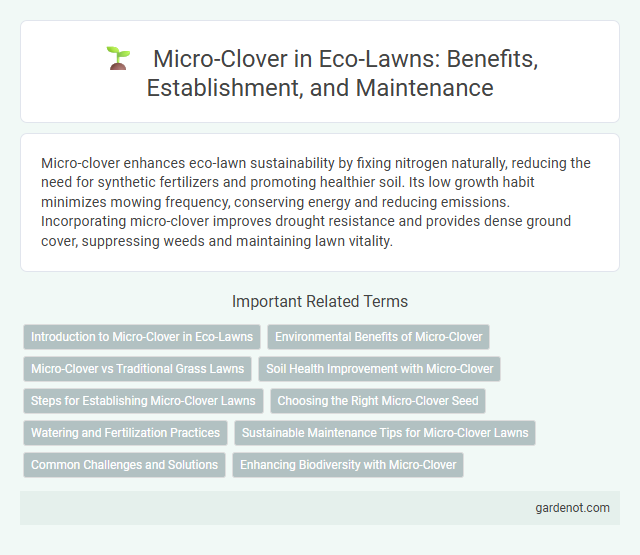Micro-clover enhances eco-lawn sustainability by fixing nitrogen naturally, reducing the need for synthetic fertilizers and promoting healthier soil. Its low growth habit minimizes mowing frequency, conserving energy and reducing emissions. Incorporating micro-clover improves drought resistance and provides dense ground cover, suppressing weeds and maintaining lawn vitality.
Introduction to Micro-Clover in Eco-Lawns
Micro-clover (Trifolium repens) enhances eco-lawns by naturally fixing nitrogen, reducing the need for synthetic fertilizers and promoting sustainable growth. Its low-growing habit blends seamlessly with grass species, improving soil health and increasing drought resistance. Incorporating micro-clover into eco-lawns supports biodiversity, encourages pollinators, and creates a resilient, eco-friendly turf solution.
Environmental Benefits of Micro-Clover
Micro-clover improves soil health by fixing nitrogen naturally, reducing the need for chemical fertilizers and lowering environmental pollution. Its dense growth suppresses weed emergence, minimizing herbicide use and promoting biodiversity in lawns. Micro-clover enhances water retention and drought resistance, contributing to sustainable lawn care and reduced water consumption.
Micro-Clover vs Traditional Grass Lawns
Micro-clover provides superior nitrogen fixation compared to traditional grass lawns, reducing the need for synthetic fertilizers and promoting sustainable growth. Its dense, low-growing habit improves drought tolerance and resilience, while maintaining a lush green appearance with less mowing. Unlike traditional grass, micro-clover supports biodiversity by attracting pollinators and enhancing soil health, making it an eco-friendly alternative for lawn care.
Soil Health Improvement with Micro-Clover
Micro-clover significantly enhances soil health by fixing atmospheric nitrogen, reducing the need for synthetic fertilizers and promoting natural nutrient cycling. Its dense root system improves soil structure, increases organic matter, and enhances water retention, supporting a resilient and sustainable lawn ecosystem. Integrating micro-clover into eco-lawns fosters microbial diversity and soil aeration, leading to healthier, more fertile soil conditions.
Steps for Establishing Micro-Clover Lawns
To establish micro-clover lawns, begin by preparing the soil through thorough tilling and removing any existing weeds or grass. Sow micro-clover seeds evenly, ensuring good seed-to-soil contact, and lightly rake the surface to cover the seeds. Maintain consistent moisture by watering gently but regularly until the micro-clover is well established, typically within 3 to 4 weeks.
Choosing the Right Micro-Clover Seed
Selecting the right micro-clover seed involves prioritizing varieties like Trifolium repens 'Pirouette' for enhanced drought tolerance and disease resistance. Opt for high-purity seeds certified for eco-lawns to ensure vigorous growth and minimal weed competition. Consider local climate and soil conditions to maximize the ecological benefits, such as nitrogen fixation and reduced mowing frequency.
Watering and Fertilization Practices
Micro-clover requires less frequent watering compared to traditional grass, thriving in well-drained soil with moderate moisture levels to prevent overwatering and root rot. Fertilization practices should prioritize low-nitrogen, balanced fertilizers to promote healthy growth without excessive leafiness, as micro-clover naturally fixes nitrogen from the air. Proper watering and fertilization enhance micro-clover's drought resistance and contribute to sustainable, eco-friendly lawn maintenance.
Sustainable Maintenance Tips for Micro-Clover Lawns
Micro-clover thrives with minimal watering and infrequent mowing, reducing resource consumption and promoting sustainable lawn care. Its nitrogen-fixing ability naturally enriches soil, decreasing the need for synthetic fertilizers and supporting environmentally friendly maintenance. Incorporating micro-clover into lawns enhances drought resistance and improves soil health, making it an ideal choice for eco-conscious homeowners.
Common Challenges and Solutions
Micro-clover in eco-lawns faces common challenges such as slower establishment, competition with aggressive grass species, and vulnerability to drought stress. To overcome these issues, integrating micro-clover with drought-tolerant grass varieties and implementing regular, moderate irrigation can enhance resilience and growth. Proper soil aeration and occasional overseeding also support healthy micro-clover populations, reducing weed invasion and improving lawn density.
Enhancing Biodiversity with Micro-Clover
Micro-clover significantly enhances biodiversity in eco-lawns by attracting pollinators such as bees and butterflies through its abundant nectar-rich flowers. Its nitrogen-fixing ability improves soil health and supports the growth of diverse plant species, reducing the need for synthetic fertilizers. Integrating micro-clover increases habitat complexity, promoting a resilient and sustainable ecosystem within urban and suburban lawn settings.
Micro-clover Infographic

 gardenot.com
gardenot.com